Chapter 5
Full coverage restoration for primary molars
Jane A. Soxman
Stainless steel crowns
Stainless steel crowns (SSCs) are the restoration of choice for primary molars of children with high-caries risk, after pulp therapy, for large, multisurface caries and interproximal preparation that extends beyond the line angle (American Academy of Pediatric Dentistry, 2014). The use of SSCs may reduce the need for repeated treatment with general anesthesia (Ohlimoba & Nelson, 2013). SSCs provide a good seal and a durable, reliable restoration (Mahoney et al., 2008).
Some parents/guardians find the appearance of the SSC to be unacceptable, so a SSC should be shown when informed consent is being obtained. With uncooperative behavior, an SSC is preferable to an esthetic crown, as an esthetic crown requires extensive tooth reduction that may create the need for vital pulpotomy and, in general, requires longer chair time. After administering local anesthesia and rubber dam placement, primary molar preparation and crown cementation for an SSC can usually be performed in less than 10 min.
Precontoured SSCs accurately duplicate the anatomy of the primary molars and require no buccal or lingual reduction during crown preparation. They provide a highly retentive “snap” fit. These SSCs are ready for immediate use, and unlike uncontoured SSCs, which must be customized with trimming and contouring for adaption, they significantly reduce chair time (Figure 5.1).
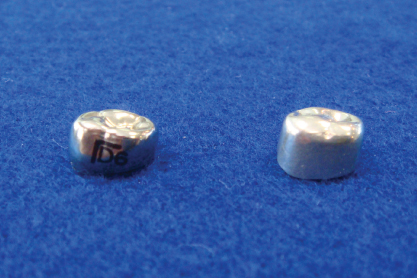
Figure 5.1 Precontoured stainless steel crown and uncontoured stainless steel crown.
Procedure for SSC
- Administer local anesthesia.
- Place rubber dam with slit technique and reduce occlusal surface 1 mm with size 6 or 8 carbide round bur with high speed (Figure 5.2).
- Perform subgingival interproximal reduction with 169 L or 170 L carbide bur with high speed (Figure 5.3).
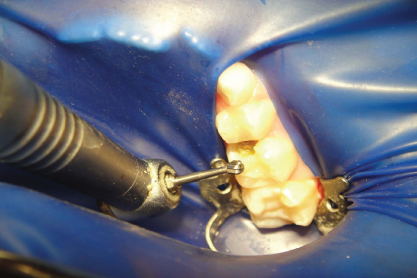
Figure 5.2 Rubber dam with slit technique for 1-mm occlusal reduction with size 8 carbide round bur with high speed.
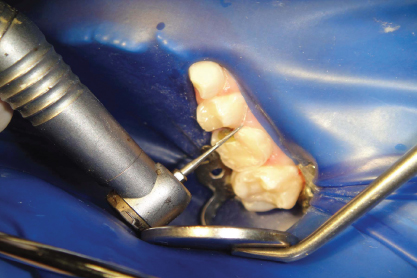
Figure 5.3 Subgingival interproximal reduction with 169L carbide bur with high speed.
When prepping the distal of a second primary molar, use caution to avoid disking the mesial of the adjacent first permanent molar. A wooden wedge, placed between the first permanent molar and the second primary molar, will provide protection for the mesial surface of the first permanent molar. Cut just inside distal marginal ridge and the mesial side of the wooden wedge (Figure 5.4). Remove the wedge and check for a white spot lesion on the mesial of the first permanent molar (Figure 5.5). If decalcification is noted, fluoride varnish may be applied as a courtesy.
- If the first permanent molar is unerupted and the rubber dam clamp must be placed on the second primary molar, a spoon curette may be used to retract the rubber dam from the distal of the second primary molar during distal interproximal preparation (Figure 5.6).
- Check for a ledge on the mesial and distal. Ledges inhibit crown seating (Figure 5.7).
- Selecting a crown:
Size 4 is most commonly used.
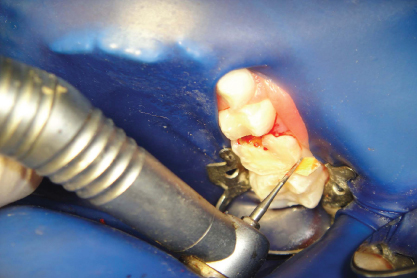
Figure 5.4 Distal reduction of second primary molar with wooden wedge to protect mesial of first permanent molar.
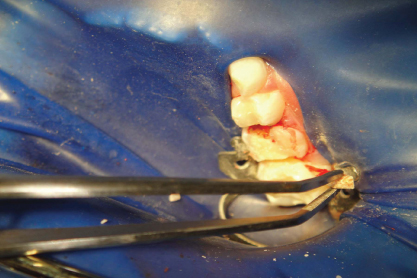
Figure 5.5 Removing wedge and checking mesial of first permanent molar for white spot lesion.
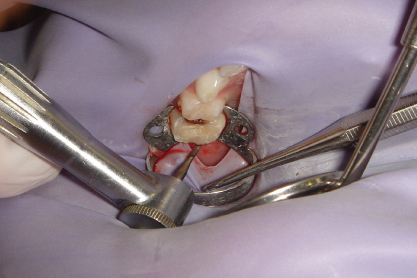
Figure 5.6 Retracting rubber dam with spoon for distal preparation of second primary molar if first permanent molar unerupted.
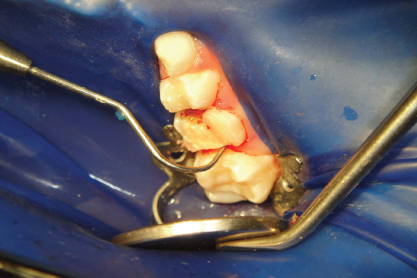
Figure 5.7 Checking for ledge with explorer.
Measuring the mesial–distal width of the primary molar before preparation with a boley gauge may be helpful to select the correct size SSC. Using this measurement, an SSC is selected (Figure 5.8a and 5.8b). After performing the SSC procedure a few times, the clinician will be able to visually estimate the size, and measuring for size selection will no longer be necessary.
- Place the SSC on the tooth, but do not fully seat the crown with the try-in. Check that SSC covers the entire crown of the primary molar. If fully seated with “snap” fit, it may be very difficult to remove (Figure 5.9).
- Place the cement of choice inside the crown – carboxylate cement or glass ionomer (GI) is typically used. The wooden end of a cotton-tipped applicator may be used to coat the inside of the crown with the cement (Figure 5.10). Overfilling will result in extrusion of cement and requires more clean-up.
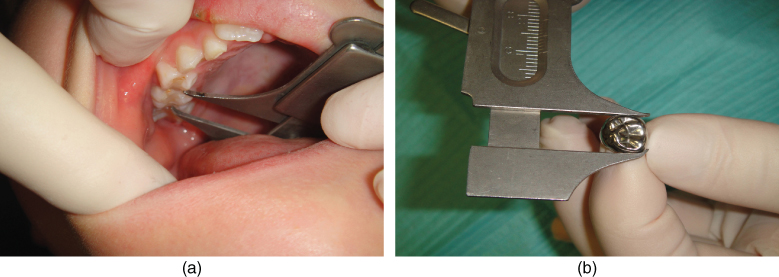
Figure 5.8 (a) Boley gauge to measure mesial–distal width of primary molar. (b) Boley gauge to measure mesial–distal width of stainless steel crown.
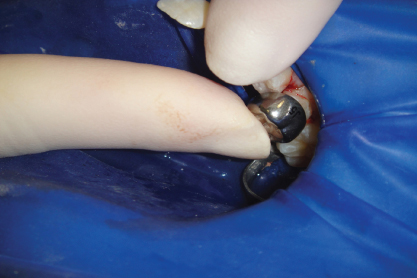
Figure 5.9 Stainless steel crown checked for size before fully seating.
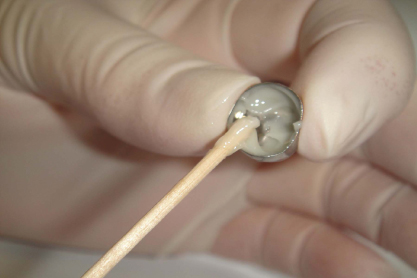
Figure 5.10 Wooden end of cotton-tipped applicator to line inside of stainless steel crown with cement.
- Initially, the crown is seated by the operator using a bite stick (Figure 5.11). If the crown is not fully seated with a “snap” fit with digital pressure on the bite stick and the child is capable of cooperating, the rubber dam is removed and the child is instructed to bite on the bite stick as hard as possible (Figure 5.12). The bite stick may initially be placed in the center of the occlusal surface of the crown and then moved to the buccal and lingual of the occlusal surface for final seating. Check to be sure that the child’s lip is not trapped under the bite stick.
- Gingival tissue may blanche after seating, but this will resolve.
- Cement is cleaned from the crown and gingival tissues with wet 2 × 2 gauze (Figure 5.13).
- Tie five to seven knots segmentally in a strand of floss and pull through the mesial and distal embrasures to remove any excess cement from that area (Figure 5.14).
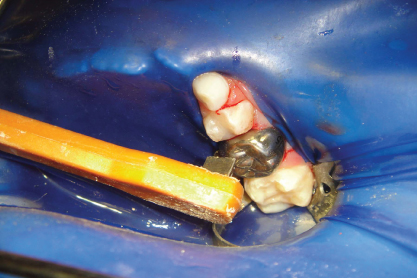
Figure 5.11 Operator seating the stainless steel crown with a bite stick.
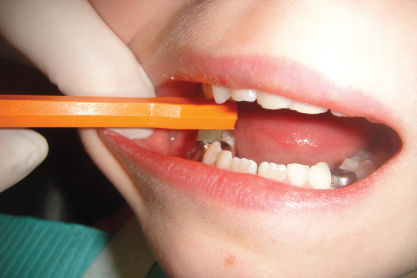
Figure 5.12 Child biting on bite stick to seat stainless steel crown.
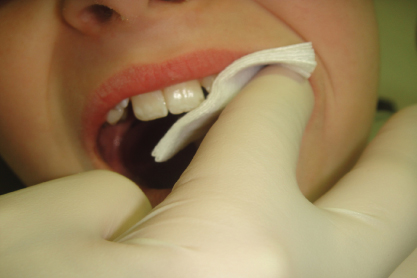
Figure 5.13 Cleaning stainless steel crown and gingiva with wet 2 × 2 gauze.
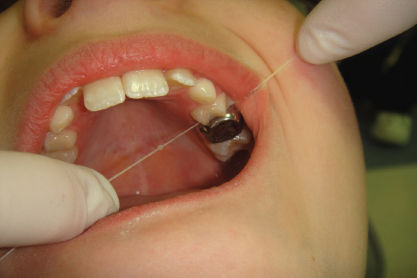
Figure 5.14 Floss with knots tied segmentally to remove interproximal cement.
With difficulty fitting
If space loss has occurred as a result of caries, it may be necessary to reduce the size of an SSC mesial-distally with a Howe plier (Figure 5.15). Because SSCs are not available in half sizes; crimping may be necessary. Crown collars may be crimped with crown and band contouring pliers or band crimping pliers, which perform equally well (Figure 5.16a and 5.16b). If unable to find a crown to fit a first primary molar, try a crown from the opposite arch and opposite (contralateral) side. For instance, if unable to find a suitable fit for a maxillary right first primary molar, a crown for a mandibular left first primary molar may be a good fit.
Stay updated, free dental videos. Join our Telegram channel

VIDEdental - Online dental courses


